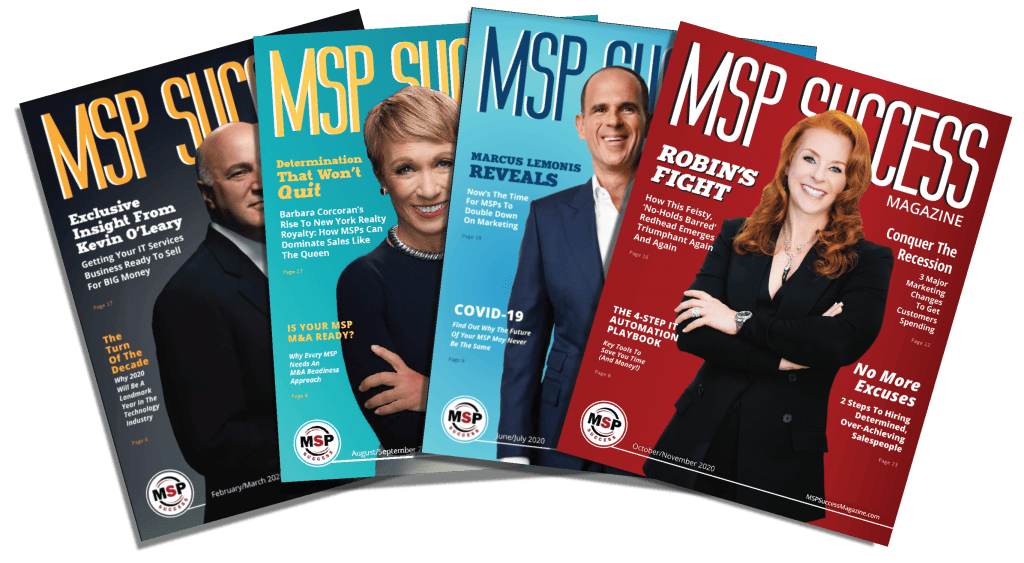In part 1, we revealed businessman, author, and former FBI hostage negotiator Chris Voss’ three-step process for dealing with clients who want to cancel their service, stop paying and weasel out of contracts. (If you missed it click here to read now.)
If you’re not sure exactly how to apply this to your client conversations, want more specific wording or would like to know when (and if) you should offer a counter-proposal, stick around. Because today we’ll reveal these answers, along with other strategies to make you feel confident during crisis negotiation with your clients.
Throughout his informative discussion with Technology Marketing Toolkit Founder Robin Robins, Voss walked through multiple examples of how to use his three-step crisis negotiation process with your MSP clients.
For example, let’s say a client emails you to tell you they need to pause paying you for a couple of months. Voss recommends you write a brief reply via email to set up a conversation on the phone.
Reply: “It sounds like you are really backed into a corner here.” (This immediate demonstration of understanding will reassure them and help get them on the phone.)
Ask: “Is it a ridiculous idea (or is it impossible) to have a 13-minute conversation on the phone about collaborating our way through this together?” (You don’t want them afraid to get on the phone with you. By specifying a short amount of time for your phone call, you build trust by giving them autonomy, a feeling of control, and predictability. By using an odd number, you stand out and leave a lasting impression.)
Important: Once you get on the phone with them, when you reach 13 minutes, respect their time by saying, “You gave me 13 minutes, we’ve reached that time and that’s all I asked for. What works better for you, reschedule to continue the conversation, or keep going?”
Follow the three steps: When you get them on the phone, follow the three steps: Open with awareness and understanding, kick it up a notch to set up collaboration, and ask thought shaping questions.
After asking questions, be mindful of shutting up and listening. Voss encouraged taking your time so you can read their reactions. “You’re not going to be able to clear the air without answering the question in their head,” Voss explained. “They don’t feel like you are trying to talk them into something, or back them into something they don’t want to do, and it allows them the illusion of control.”
Stick to no-oriented questions.
During your conversation, the goal is to keep them feeling safe and secure. Voss says it’s better to ask open-ended questions, however, if you ask them closed questions during crisis negotiation, he advises you to stay away from “yes-oriented” questions. “Stick to asking them no-oriented questions,” Voss said. “Saying no makes them feel safe and secure.”
Examples of “Yes” oriented vs. “No” oriented questions are:
• Would you agree? • Do you disagree?
• Do you have a few minutes? • Is now a bad time?
• Can you give me this? • Would it be out of the question…?
• Does that make sense? • Is it ridiculous?
• Do you want this positive gain? • Is it a bad idea?
• Can you tell me more about this? • Am I out of line?
• Do you want to get this done? • Have you given up on…?
Use go-to labels.
When they disagree, this is the time to not push past that. Voss talked about using labels to further the conversation when a client says something contrary to what you are discussing, or they say something you don’t understand. “You will be shocked at how far you will get by using these go-to labels,” Voss said. These will allow you to avoid going right to giving a discount or changing your agreement terms. He explained that often when your client says something contrary, they are testing you. Using the following labels will demonstrate understanding and that you want to collaborate:
- “It sounds like (fill in the blank) is important to you.”
- “It sounds like you’ve given this a lot of thought.”
- “It sounds like you have a reason for saying that.”
- “It sounds like you have a reason for (name the behavior/action taken)?”
“Labels are generally best followed by dynamic silence,” Voss said. By listening to their response first, you’ll gain insight into what they are thinking. Which label you use depends on the situation. For example, your go-to label when a client calls and asks for a discount should be, “It sounds like you feel backed into a corner.”
When should you offer a counterproposal?
Voss cautioned against offering a counterproposal too quickly. Instead, he recommends using the label: “Sounds like you have been thinking through a lot of options.” This gives them the opportunity to share those options before you give them a counterproposal.
What to say if they are just trying to get a discount or exploit the situation?
If after using a label, they reveal that they are just trying to get all of their vendors to give them a discount, then respond with “Sounds like you aren’t getting any value out of the service I’m providing.”
Voss says that whenever you talk about price, rather than conceding, immediately move the conversation to talk about value. “It’s astonishing what people will say that is against their best interest because the desire to correct is so overwhelming and such an addiction,” Voss said.
How do you prepare for these conversations?
“You fall to your highest level of preparation,” Voss said. To prepare, we recommend you listen to the recorded training with Chris Voss here, review the slide deck and practice what you will say and how you will say it. Even roleplay with people in your accountability groups. Write out what you will say. “Handwriting engages the brain in a completely different way from typing,” Voss said. “So, handwrite your notes and see how your brain reacts a different way.” This will ensure you are prepared should you get a call or you’re making calls yourself.
When do you start the conversation?
Do you wait until clients contact you or do you call them now? Voss recommends that you let your circumstance dictate your strategy. If they have a payment that is overdue, or they’ve gone silent, call them and use this approach, even if they haven’t contacted you first. If you have someone who you want to absolutely stay in communication with, then you may want to call them to see how they are doing and ask what else they need from you to keep them going.
“Vision drives decision,” Voss said. “If you don’t talk to them, then their vision is cloudy, and it is clouding their decision-making.” If they are making bad decisions, clouded by short-term circumstances, and losing sight of the long-term, you need to remind them that the post apocalypse is coming.
Remember, the objective is to make everyone feel safe and secure and demonstrate collaboration. These conversations will not only help preserve your relationships; it can strengthen them.
“The last impression is the lasting impression,” Voss said. “People remember experiences based on the most intense moment and how it ended.”
For free resources from Chris Voss, visit BlackSwanLtd.com.












